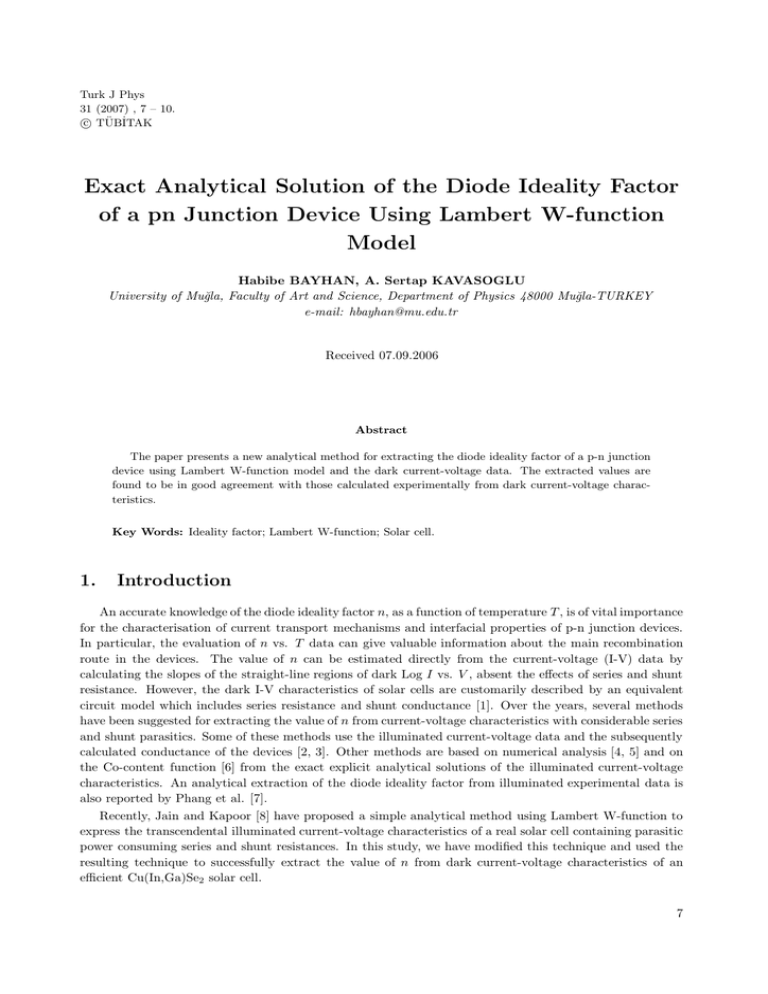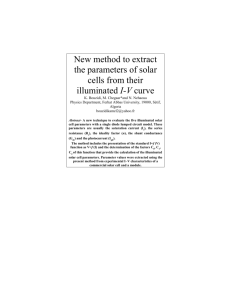Exact Analytical Solution of the Diode Ideality Factor of a pn Junction
advertisement

Turk J Phys 31 (2007) , 7 – 10. c TÜBİTAK Exact Analytical Solution of the Diode Ideality Factor of a pn Junction Device Using Lambert W-function Model Habibe BAYHAN, A. Sertap KAVASOGLU University of Muğla, Faculty of Art and Science, Department of Physics 48000 Muğla-TURKEY e-mail: hbayhan@mu.edu.tr Received 07.09.2006 Abstract The paper presents a new analytical method for extracting the diode ideality factor of a p-n junction device using Lambert W-function model and the dark current-voltage data. The extracted values are found to be in good agreement with those calculated experimentally from dark current-voltage characteristics. Key Words: Ideality factor; Lambert W-function; Solar cell. 1. Introduction An accurate knowledge of the diode ideality factor n, as a function of temperature T , is of vital importance for the characterisation of current transport mechanisms and interfacial properties of p-n junction devices. In particular, the evaluation of n vs. T data can give valuable information about the main recombination route in the devices. The value of n can be estimated directly from the current-voltage (I-V) data by calculating the slopes of the straight-line regions of dark Log I vs. V , absent the effects of series and shunt resistance. However, the dark I-V characteristics of solar cells are customarily described by an equivalent circuit model which includes series resistance and shunt conductance [1]. Over the years, several methods have been suggested for extracting the value of n from current-voltage characteristics with considerable series and shunt parasitics. Some of these methods use the illuminated current-voltage data and the subsequently calculated conductance of the devices [2, 3]. Other methods are based on numerical analysis [4, 5] and on the Co-content function [6] from the exact explicit analytical solutions of the illuminated current-voltage characteristics. An analytical extraction of the diode ideality factor from illuminated experimental data is also reported by Phang et al. [7]. Recently, Jain and Kapoor [8] have proposed a simple analytical method using Lambert W-function to express the transcendental illuminated current-voltage characteristics of a real solar cell containing parasitic power consuming series and shunt resistances. In this study, we have modified this technique and used the resulting technique to successfully extract the value of n from dark current-voltage characteristics of an efficient Cu(In,Ga)Se2 solar cell. 7 BAYHAN, KAVASOGLU 2. Theory and Calculations The dark forward current of a typical pn junction device can be expressed by the relation q(V − IRs ) V − IRs + I◦ (exp − 1), I= Rsh nkT (1) where Iand V are the terminal current and voltage, I◦ is the saturation current, k is Boltzmann’s constant, and Rs and Rsh are the series and shunt resistances, respectively. The explicit solution for this equation, which is transcendental in nature using W-function, is as kT q Rs Rsh I◦ q Rsh (V + I◦ Rs ) V − Io Rsh I=n Lambert W . (2) exp ( ) + qRs n k T (Rs + Rsh) n k T (Rs + Rsh ) Rs + Rsh For a p-n junction device, an equation containing Iand n can be determined by substituting the experimentally determined values of I◦ , Rs , Rsh and V into equation (2). Figure 1. The dark I-V characteristics of a Cu(In, Ga)Se2 solar cell at room temperature. Table 1. The diode parameters of a n-CdS/p-Cu(In,Ga)Se2 solar cell determined in the dark. T (K) 300 Rsh (Ω) [9, 10] 2.3×105 Rs (Ω) [9, 10] 10 I(A) [9, 11] V (0.4 V) V (0.7 V) −5 4.70×10 1.20×10−3 Io (A) [9, 11] Region I Region II −6 1.05×10 4.50×10−7 A n-CdS/p-Cu(In,Ga)Se2 solar cell with conversion efficiency of about 13% is considered a p-n junction device. The room temperature current-voltage (I-V) characteristic of this solar cell is plotted in Figure 1. The experimental data was analysed by dividing the plot into two distinct regions: region I being 0.2 V > V > 0.6 V, and region II being 0.6V > V > 0.8 V. The values of I◦ , Rs and Rsh deduced from current-voltage [9] and impedance [9–11] measurements are given in Table 1. The value of V is selected randomly in the voltage region considered. For example, by taking V = 0.4 V for region I and V = 0.7 V for region II, the n vs. I data can be estimated at 300 K using equation (2) as Iregion I = 2.58 × 10 8 −3 4.06959 × 10−4 · n · Lambert W exp n 15.5027 n + 6.89 × 10−7 (3a) BAYHAN, KAVASOGLU Iregion II = 2.58 × 10−3 · n · Lambert W 1.744 × 10−4 exp n 27.130 n + 2.593 × 10−6 (3b) Figure 2 shows typical plots of I(n) for regions I and II evaluated at 300 K. The value of the ideality factor is then extracted from this plot using the value of dark forward current reciprocal to the voltage selected in equation (3). The values of n at which current I (V = 0.4 V ) = 4.7 × 10−5 and I (V = 0.7 V ) = 1.20 × 10−3 are about 4.078 and 3.439, respectively. The confidence intervals of the fits are about 0.9996 and 0.9993 for V = 0.4 V and V = 0.7 V, respectively. These values of n accord well with those calculated from equation (1) and from the slopes of the straight-line regions of Log I(V ) values given in Figure 2. Figure 2. The current I as a function of ideality n factor characteristics at 300 K. Table 2. Ideality factors obtained by different methods. n Temperature (K) Experimental Region [9, 11] Region Lambert Region W-function Region method Equation (1) Region Region I II I II 300 4.064 3.457 4.078 3.438 I II 4.077 3.439 For comparison, we employ an analytical method proposed by Phang et al. [5] to estimate value of the ideality factor at room temperature. By this model the analytical expression of the diode ideality factor is given by n= kT ln Isc − Vm Rsho q (Vm + Im Rso − Voc ) + − Im − ln Isc − RVoc sh Im Isc −(Voc /Rsho ) , (4) where Voc , Isc , Vm , Im , Rso and Rsho are the open circuit voltage, short circuit current, maximum point voltage and current, and series and shunt resistances under illumination, respectively. By using the room temperature solar cell parameters of n-CdS/p-Cu(In, Ga)Se2 solar cell (Rso = 10 Ω, Rsho = 15 × 104 Ω, Voc = 0.610 V, Isc = 13 mA, Vm = 0.516 V, Im = 8.0 mA), the average value of n is estimated as about 1.589. This value is very different from the estimated value of n by experimental and W-function methods at the room temperature. It was reported that the accuracy of the Phang’s model is strongly sensitive to the value of Rs and acceptable results can be provided when Rs < 200 mΩ [7]. However, for our solar cell 9 BAYHAN, KAVASOGLU the value of Rs is estimated as about 10 Ω in the dark and as about 6 Ω under illumination (730 W/m2 ). Thus, the large difference obtained with Phang’s method could be ascribed to the relatively high value of the series resistance of the CIGS solar cell studied in this work. 3. Conclusion An analytical method based on Lambert W-function was shown to be applicable for the determination of the value of the diode ideality factor at different temperatures of a typical p-n junction device using its dark current-voltage-temperature data. The method was successfully applied to an efficient n-CdS/pCu(In, Ga)Se2 solar cell and the results obtained are in good agreement with those published previously. An another well-established analytical method proposed by Phang et al. [7] was also applied to estimate the average value of the ideality factor of the same solar cell using its illuminated current-voltage characteristics at 300 K. However, the n value obtained by Phang’s method is significantly different. This discrepancy seems to be strongly correlated to the high value of the parasitic series resistance of the Cu(In, Ga)Se2 solar cell. Hence it proposed that the analytical method based on the dark current-voltage data and the Lambert W-function could be useful for carrying out highly accurate computations for the diode ideality factor of p-n junction devices modelled with relatively high series resistance values. References [1] D. K. Schroeder, Semiconductor material and device characterisation, (Wiley, New York, 1990). [2] M. Chegaar, Z. Quennoughi and A. Hoffmann, Solid-State Electron., 45, (2001), 293. [3] M. Chegaar, Z. Quennoughi and F. Guechi, Vacuum, 75, (2004), 367. [4] C. M. Singal, Solar Cells, 3, (1981), 163. [5] G. L. Aurjo and E. Sanchez, Solar Cell, 22, (1987), 15. [6] A. Ortiz-Conde, F. J. Garcia Sánchez and Juan Muci, Solar Energy Materials and Solar Cells, 90, (2006), 352. [7] DSH Chan, JCH Phang, IEEE Transactions on Electron Devices, Ed-34, (1987), 286. [8] A. Jain and A. Kapoor, Solar Energy Materials and Solar Cells, 85, (2005), 391. [9] H. Bayhan and A. S. Kavasoglu, Solid State Electron., 49, (2005), 991. [10] H. Bayhan and A. S. Kavasoglu, Solar Energy, 80, (2006), 1160. [11] A. S. Kavasoglu, MSc. Thesis, Department of Physics, University of Muğla, Muğla, Turkey, 2000. 10
